

 |
Search the Site with

|
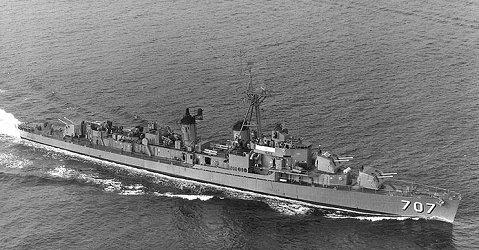 | 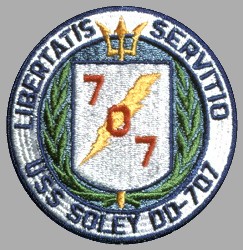 |
USS SOLEY was one of the ALLEN M. SUMNER - class destroyers and the first ship in the Navy to bear the name. Unlike many other ships in her class SOLEY did not receive a FRAM (Fleet Rehabilitation and Modernization) overhaul. Decommissioned on February 13, 1970, SOLEY was sunk as a target in September 1970.
| General Characteristics: | Awarded: 1942 |
| Keel laid: April 18, 1944 | |
| Launched: September 8, 1944 | |
| Commissioned: December 7, 1944 | |
| Decommissioned: April 15, 1947 | |
| Recommissioned: January 29, 1949 | |
| Decommissioned: February 13, 1970 | |
| Builder: Federal Shipbuilding & Drydock Co., Kearny, NJ. | |
| Propulsion system: four boilers, General Electric geared turbines; 60,000 SHP | |
| Propellers: two | |
| Length: 376.3 feet (114.7 meters) | |
| Beam: 41 feet (12.5 meters) | |
| Draft: 18.7 feet (5.7 meters) | |
| Displacement: approx. 3,300 tons full load | |
| Speed: 34 knots | |
| Armament: three 5-inch/38 caliber twin mounts, two 3-inch/50 caliber twin guns and one single 3-inch/50 caliber gun, two Mk-10 Hedgehogs, Mk-32 ASW torpedo tubes (two triple mounts) | |
| Crew: 336 |
Crew List:
This section contains the names of sailors who served aboard USS SOLEY. It is no official listing but contains the names of sailors who submitted their information.
USS SOLEY Cruise Books:
USS SOLEY History:
USS SOLEY was laid down on 18 April 1944 at Kearny, N.J., by Federal Shipbuilding and Drydock Co.; launched on 8 September 1944; sponsored by Mrs. C. M. Cornfelt, Mrs. Howard C. Dickinson, and Mrs. Howard C. Dickinson, Jr.; and commissioned on 7 December 1944, Comdr. John S. Lewis in command.
SOLEY sailed on 29 December 1944 for a shakedown cruise in Bermuda waters. On 1 February 1945, she headed back toward the Brooklyn Navy Yard for post-shakedown availability before joining the Atlantic Fleet at Norfolk, Va., on 18 February. After serving in the Virginia Capes area as a training ship, she was ordered to the west coast.
SOLEY arrived at San Diego on 17 August. She reached Pearl Harbor 10 days later and was routed onward to the Marshall Islands, arriving at Kwajalein on 5 September. SOLEY joined Task Unit (TU) 96.15.1, a Military Government Unit, which sortied for Kusaie Island, on 7 September, to take part in the acceptance of the surrender of Japanese forces. The surrender articles were signed on the 8th, and SOLEY remained at Kusaie as station ship until mid-October.
From 14 October to 17 December, the destroyer operated directly under the Commander of the Marshall-Gilbert Islands Area. On two occasions, she was called upon to transport Japanese prisoners from outlying islands to Kwajalein for possible trial before the War Crimes Commission. The most prominent among them was Rear Admiral Sakaibara, the commander at Wake Island.
On 18 December, SOLEY departed the Marshall Islands for Japan and duty with the occupation forces, arriving at Yokosuka on 27 December 1945. In February 1946, the destroyer was ordered to return to Casco Bay, Maine, via Hawaii, Long Beach, and the Panama Canal. In December 1946, the ship sailed to Guantanamo Bay, Cuba, for training exercises and next reported to Charleston, S.C., for inactivation with the Atlantic Reserve Fleet. The destroyer was placed in reserve, out of commission, on 15 April 1947.
SOLEY was placed in commission again on 29 January 1949. After pre-shakedown training, the ship entered the Charleston (S.C.) Naval Shipyard for an overhaul from March through May. Following shakedown in Guantanamo Bay, SOLEY joined Destroyer Squadron (DesRon) 20, with its home port at Norfolk. She operated with her squadron along the east coast until 4 August 1950 when she sailed to the Mediterranean Sea for duty with the 6th Fleet. The destroyer represented the United States at the funeral of King Gustaf V of Sweden. She was in Stockholm on 9 November, with Rear Admiral Walter F. Boone, the Commander in Chief, Eastern Atlantic and Mediterranean Naval Forces, on board. She rejoined the 6th Fleet in December and, in January 1951, returned to Norfolk for an overhaul.
Yard work was completed on 15 May, and the ship proceeded to Guantanamo Bay for refresher training. SOLEY resumed her routine east coast operations which she continued until May 1952. On 15 May, she got underway, with three other destroyers, for Japan, via the Panama Canal and Pearl Harbor, arriving at Yokosuka on 18 June.
SOLEY steamed north to the Korean war zone and, from 22 June to 1 July, operated in the antisubmarine screen of Task Force (TF) 77, the fast carrier task force. During this period, the carriers conducted raids against the North Korean hydroelectric power stations on the Yalu River. SOLEY and HELENA (CA 75) were detached from the task force to go to the "bomb-line" to provide shore bombardment in support of ground troops.
SOLEY and HELENA (CA 75) joined IOWA (BB 61), and the trio conducted shore bombardment at Wonsan, Kojo, and Kosong through 9 July. From 21 July to 22 August, the destroyer operated with the United Nations Blockade and Escort Force (TF 95) in the Wonsan-Hung-nam area and north to Ch'aho. She bombarded railroad and highway bridges and tunnels. She took on board more than 60 prisoners and refugees from sampans in the bombardment area. During the first half of September, the destroyer operated with an antisubmarine hunter-killer group. She returned to TF 77 on 15 September and operated with it until proceeding to Sasebo on 9 October.
SOLEY then departed the Far East on 19 October for Norfolk, but not on a direct route. She returned via Malaya, Ceylon, and Arabia; proceeded through the Red Sea and the Suez Canal; and made stops at ports in Italy and France, and Gibraltar; and finally arrived at Norfolk on 12 December 1952. On 25 January 1953, SOLEY sailed for operations in the Caribbean. Upon her return to Norfolk, she commenced an overhaul and was there from 30 April to 21 August. Refresher training was held from 3 September to 2 November, followed by preparations for her second world cruise.
On 4 January 1954, SOLEY, STRONG (DD 758), and BARTON (DD 722) stood out of Norfolk en route to the west coast. They transited the Panama Canal on 9 January and anchored briefly at San Diego where STICKELL (DDR 888) joined the group before continuing west. The destroyers called at Pearl Harbor and Midway before arriving at Yokosuka on 7 February. She completed a patrol off Korea, made port calls from Hong Kong to South Africa, and returned to Norfolk on 10 August 1954.
SOLEY operated along the east coast until being deployed to the Mediterranean from July 1956 to February 1957 and again from July to December 1957. She was participating in "Springboard 58," the annual Caribbean exercise, during January 1958 when she and BARTON (DD 722) rescued the crew of SS ST. ELETIERO which later sank. In subsequent years, SOLEY was deployed to the Mediterranean from October 1958 to April 1959; from September 1961 to March 1962; and from 29 March to 4 September 1963. In 1962, during the Cuban crisis, she served with the quarantine forces off Cuba from October to December.
On 1 March 1964, SOLEY's homeport was changed to Charleston, S.C.; and, on 1 April, she was assigned duty as a Naval Reserve Training ship. She served in this capacity until being decommissioned on 13 February 1970. SOLEY was struck from the Navy list on 1 July 1970 and sunk as a target.
SOLEY received one battle star for service in Korea.
About the Ship's Name:
James R. Soley born on 1 October 1850 in Roxbury, Mass. - graduated from Harvard College in 1870. He was appointed Assistant Professor of Ethics and English at the United States Naval Academy on 1 October 1871. Only two years later, he became Head of the Department of English Studies, History, and Law.
On 9 June 1882, Soley was assigned to the Bureau of Navigation. He served as Superintendent of the Office of Naval War Records, and he headed the Navy Department Library. During this duty, Soley began the collection of the naval documents of the Civil War and started work which culminated in the publication of the 31-volune collection "The Official Records of the Union and Confederate Navies in the War of the Rebellion". These years also saw the publication of several of Soley's books and articles on American naval history.
While serving in Washington, Soley studied law at Columbian (now called George Washington) University and received his law degree in 1890. On 16 July 1899, he resigned his commission so that he would be free to serve as Assistant Secretary of the Navy.
After retiring from public service in March 1893, Soley practiced law in New York City, specializing in international law. In this field, he won renown as counsel for Venezuela, in 1899 during the arbitration at Paris of that nation's boundary dispute with the United Kingdom. Soley died in New York City on 11 September 1911.
USS SOLEY Image Gallery:
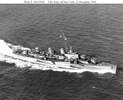 | 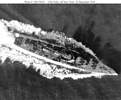 | 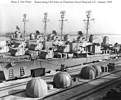 | 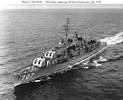 | 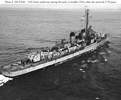 |
 Back to Destroyers list.
Back to Destroyers list.  Back to ships list.
Back to ships list.  Back to selection page.
Back to selection page.  Back to 1st page.
Back to 1st page.